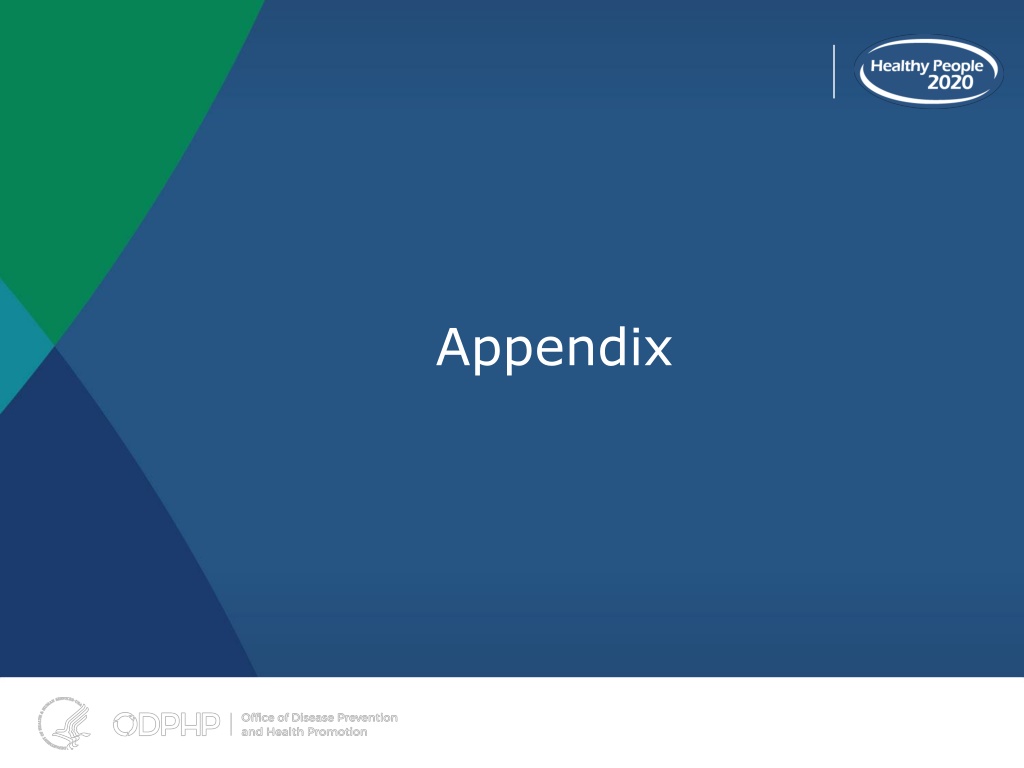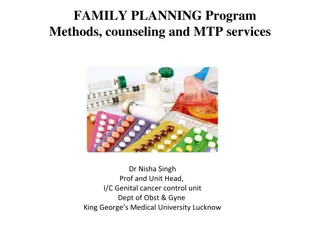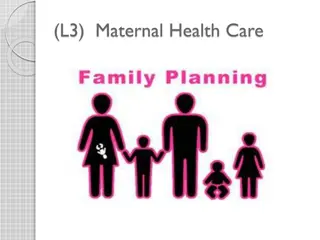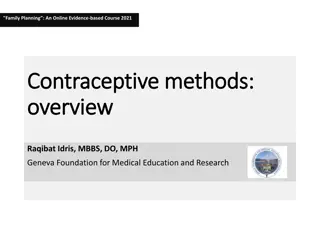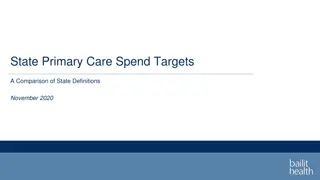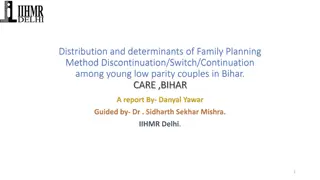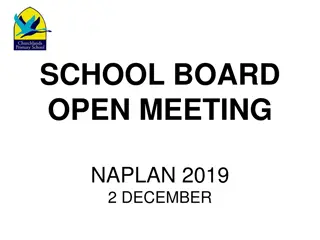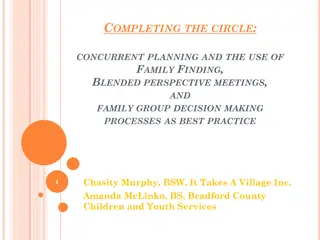Family Planning Targets and Objectives Overview
This document outlines various objectives related to family planning, including increasing the proportion of intended pregnancies, reducing pregnancies despite contraceptive use, and improving access to reproductive health services. It discusses targets for different age groups and emphasizes education on birth control methods and abstinence for adolescents.
Download Presentation

Please find below an Image/Link to download the presentation.
The content on the website is provided AS IS for your information and personal use only. It may not be sold, licensed, or shared on other websites without obtaining consent from the author. Download presentation by click this link. If you encounter any issues during the download, it is possible that the publisher has removed the file from their server.
E N D
Presentation Transcript
Objective Status: Family Planning Target met Improving Little/No change Getting worse Baseline only Developmental Informational FP-1 Increase the proportion of pregnancies that are intended FP-2 Reduce the proportion of females experiencing pregnancy despite use of a reversible contraceptive method FP-3.1 Increase the proportion of publicly funded family planning clinics that offer the full range of FDA-approved methods of contraception onsite FP-3.2 Increase the proportion of publicly funded family planning clinics that offer emergency contraception onsite FP-5 Reduce the proportion of pregnancies conceived within 18 months of a previous birth FP-6 Increase the proportion of females at risk of unintended pregnancy or their partners who used contraception at most recent sexual intercourse FP-7.1 Increase the proportion of sexually experienced females aged 15 to 44 years who received reproductive health services in the past 12 months FP-7.2 Increase the proportion of sexually experienced males aged 15 to 44 years who received reproductive health services FP-8.1 Reduce pregnancies among adolescent females aged 15 to 17 years FP-8.2 Reduce pregnancies among adolescent females aged 18 to 19 years FP-9.1 Increase the proportion of female adolescents aged 15 to 17 years who have never had sexual intercourse FP-9.2 Increase the proportion of male adolescents aged 15 to 17 years who have never had sexual intercourse
Objective Status: Family Planning Continued Target met Improving Little/No change Getting worse Baseline only Developmental Informational FP-9.3 Increase the proportion of female adolescents aged 15 years and under who had never had sexual intercourse FP-9.4 Increase the proportion of male adolescents aged 15 years and under who had never had sexual intercourse FP-10.1 Increase the proportion of sexually active females aged 15 to 19 years who use a condom at first intercourse FP-10.2 Increase the proportion of sexually active males aged 15 to 19 years who use a condom at first intercourse FP-10.3 Increase the proportion of sexually active females aged 15 to 19 years who use a condom at last intercourse FP-10.4 Increase the proportion of sexually active males aged 15 to 19 years who use a condom at last intercourse FP-11.1 Increase the proportion of sexually active females aged 15 to 19 years who use a condom and hormonal or intrauterine contraception at first intercourse FP-11.2 Increase the proportion of sexually active males aged 15 to 19 years who use a condom and whose partner used hormonal or intrauterine contraception at first intercourse FP-11.3 Increase the proportion of sexually active females aged 15 to 19 years who use a condom and hormonal or intrauterine contraception at last intercourse
Objective Status: Family Planning Continued Target met Improving Little/No change Getting worse Baseline only Developmental Informational FP-11.4 Increase the proportion of sexually active males aged 15 to 19 years who use a condom and whose partner used hormonal or intrauterine contraception at last intercourse FP-12.1 Increase the proportion of female adolescents who received formal instruction on abstinence before they were 18 years old FP-12.2 Increase the proportion of male adolescents who received formal instruction on abstinence before they were 18 years old FP-12.3 Increase the proportion of female adolescents who received formal instruction on birth control methods before they were 18 years old FP-12.4 Increase the proportion of male adolescents who received formal instruction on birth control methods before they were 18 years old FP-12.5 Increase the proportion of female adolescents who received formal instruction on HIV/AIDS prevention before they were 18 years old FP-12.6 Increase the proportion of male adolescents who received formal instruction on HIV/AIDS prevention before they were 18 years old FP-12.7 Increase the proportion of female adolescents who received formal instruction on sexually transmitted diseases before they were 18 years old FP-12.8 Increase the proportion of male adolescents who received formal instruction on sexually transmitted diseases before they were 18 years old
Objective Status: Family Planning Continued Target met Improving Little/No change Getting worse Baseline only Developmental Informational FP-13.1 Increase the proportion of female adolescents who talked to a parent or guardian about abstinence before they were 18 years old FP-13.2 Increase the proportion of male adolescents who talked to a parent or guardian about abstinence before they were 18 years old FP-13.3 Increase the proportion of female adolescents who talked to a parent or guardian about birth control methods before they were 18 years old FP-13.4 Increase the proportion of male adolescents who talked to a parent or guardian about birth control methods before they were 18 years old FP-13.5 Increase the proportion of female adolescents who talked to a parent or guardian about HIV/AIDS prevention before they were 18 years old FP-13.6 Increase the proportion of male adolescents who talked to a parent or guardian about HIV/AIDS prevention before they were 18 years old FP-13.7 Increase the proportion of female adolescents who talked to a parent or guardian about sexually transmitted diseases before they were 18 years old FP-13.8 Increase the proportion of male adolescents who talked to a parent or guardian about sexually transmitted diseases before they were 18 years old FP-14.1 Increase the number of States that set the income eligibility level for Medicaid-covered family planning services at or above 133% of the poverty threshold FP-14.2 Increase the number of States that set the income eligibility level for Medicaid-covered family planning services at or above 185% of the poverty threshold
Objective Status: Family Planning Continued Target met Improving Little/No change Getting worse Baseline only Developmental Informational FP-15 Increase the proportion of females in need of publicly supported contraceptive services and supplies who receive those services and supplies FP-16.1 Increase the percentage of adult females aged 20 to 44 years who are at risk of unintended pregnancy that adopt or continue use of the most effective or moderately effective methods of contraception FP-16.2 Increase the percentage of adolescent females aged 15 to 19 years who are at risk of unintended pregnancy that adopt or continue use of the most effective or moderately effective methods of contraception
Current HP2020 Objective Status: Family Planning Measurable objectives: 43 Target met or exceeded 7.0% (n = 3) Total objectives: 44 Baseline Only 14.0% (n = 6) Improving 9.3% (n = 4) Archived 2.3% (n = 1) Getting worse 11.6% (n = 5) 1 97.7% (n = 43) Little or no detectable change 58.1% (n = 25)
Objective Status: Maternal, Infant, and Child Health Target met Improving Little/No change Getting worse Baseline only Developmental Informational Morbidity and Mortality MICH-1.1 Reduce the rate of fetal deaths at 20 or more weeks of gestation MICH-1.2 Reduce the rate of fetal and infant deaths during perinatal period (28 weeks of gestation to less than 7 days after birth) MICH-1.3 Reduce the rate of all infant deaths (within 1 year) MICH-1.4 Reduce the rate of neonatal deaths (within the first 28 days of life) MICH-1.5 Reduce the rate of postneonatal deaths (between 28 days and 1 year) MICH-1.6 Reduce the rate of infant deaths related to birth defects (all birth defects) MICH-1.7 Reduce the rate of infant deaths related to birth defects (congenital heart defects) MICH-1.8 Reduce the rate of infant deaths from sudden infant death syndrome (SIDS) MICH-1.9 Reduce the rate of infant deaths from sudden unexpected infant deaths (includes SIDS, Unknown Cause, Accidental Suffocation, and Strangulation in Bed) MICH-2 Reduce the 1-year mortality rate for infants with Down syndrome MICH-3.1 Reduce the rate of deaths among children aged 1 to 4 years MICH-3.2 Reduce the rate of deaths among children aged 5 to 9 years MICH-4.1 Reduce the rate of deaths among adolescents aged 10 to 14 years MICH-4.2 Reduce the rate of deaths among adolescents aged 15 to 19 years MICH-4.3 Reduce the rate of deaths among young adults aged 20 to 24 years MICH-5 Reduce the rate of maternal mortality
Objective Status: Maternal, Infant, and Child Health Continued Target met Improving Little/No change Getting worse Baseline only Developmental Informational Morbidity and Mortality Continued MICH-6 Reduce maternal illness and complications due to pregnancy (complications during hospitalized labor and delivery) MICH-7.1 Reduce cesarean births among low-risk women with no prior cesarean births MICH-7.2 Reduce cesarean births among low-risk women giving birth with a prior cesarean birth MICH-8.1 Reduce low birth weight (LBW) MICH-8.2 Reduce very low birth weight (VLBW) MICH-9.1 Reduce total preterm births MICH-9.2 Reduce late preterm or live births at 34 to 36 weeks of gestation MICH-9.3 Reduce live births at 32 to 33 weeks of gestation MICH-9.4 Reduce very preterm or live births at less than 32 weeks of gestation Pregnancy Health and Behaviors MICH-10.1 Increase the proportion of pregnant women who receive prenatal care beginning in the first trimester MICH-10.2 Increase the proportion of pregnant women who receive early and adequate prenatal care MICH-11.1 Increase abstinence from alcohol among pregnant women MICH-11.2 Increase abstinence from binge drinking among pregnant women MICH-11.3 Increase abstinence from cigarette smoking among pregnant women MICH-11.4 Increase abstinence from illicit drugs among pregnant women
Objective Status: Maternal, Infant, and Child Health Target met Improving Little/No change Getting worse Baseline only Developmental Informational Pregnancy Health and Behaviors Continued MICH-13 Increase the proportion of mothers who achieve a recommended weight gain during their pregnancies Preconception Health and Behaviors MICH-14 Increase the proportion of women of childbearing potential with intake of at least 400 g of folic acid daily from fortified foods or dietary supplements MICH-15 Reduce the proportion of women of childbearing potential who have lower (below the 25th percentile) red blood cell folate concentrations MICH-16.1 Increase the proportion of women delivering a live birth who discussed preconception health with a health care worker prior to pregnancy MICH-16.2 Increase the proportion of women delivering a live birth who took multivitamins/folic acid prior to pregnancy MICH-16.3 Increase the proportion of women delivering a live birth who did not smoke prior to pregnancy MICH-16.4 Increase the proportion of women delivering a live birth who did not drink alcohol prior to pregnancy MICH-16.5 Increase the proportion of women delivering a live birth who had a healthy weight prior to pregnancy MICH-16.6 Increase the proportion of women delivering a live birth who used a most effective or moderately effective contraception method postpartum MICH-17.1 Reduce the proportion of women aged 18 to 44 years who have impaired fecundity
Objective Status: Maternal, Infant, and Child Health Target met Improving Little/No change Getting worse Baseline only Developmental Informational Preconception Health and Behaviors Continued MICH-17.2 Reduce the proportion of men aged 18 to 44 years who have impaired fecundity Postpartum Health and Behavior MICH-18 Reduce postpartum relapse of smoking among women who quit smoking during pregnancy MICH-19 Increase the proportion of women giving birth who attend a postpartum care visit with a health worker MICH-34 Decrease the proportion of women delivering a live birth who experience postpartum depressive symptoms Infant Care MICH-20 Increase the proportion of infants who are put to sleep on their backs MICH-21.1 Increase the proportion of infants who are ever breastfed MICH-21.2 Increase the proportion of infants who are breastfed at 6 months MICH-21.3 Increase the proportion of infants who are breastfed at 1 year MICH-21.4 Increase the proportion of infants who are breastfed exclusively through 3 months MICH-21.5 Increase the proportion of infants who are breastfed exclusively through 6 months MICH-22 Increase the proportion of employers that have worksite lactation support programs MICH-23 Reduce the proportion of breastfed newborns who receive formula supplementation within the first 2 days of life MICH-24 Increase the proportion of live births that occur in facilities that provide recommended care for lactating mothers and their babies
Objective Status: Maternal, Infant, and Child Health Target met Improving Little/No change Getting worse Baseline only Developmental Informational Disability and Other Impairments MICH-25 Reduce the occurrence of fetal alcohol syndrome (FAS) MICH-26 Reduce the proportion of children diagnosed with a disorder through newborn blood spot screening who experience developmental delay requiring special education services MICH-27.1 Reduce the proportion of children aged 8 years with cerebral palsy born low birth weight (less than 2,500 grams) MICH-27.2 Reduce the proportion of children aged 8 years with cerebral palsy born very low birth weight (less than 1,500 grams) MICH-28.1 Reduce the occurrence of spina bifida MICH-28.2 Reduce the occurrence of anencephaly MICH-29.1 Increase the proportion of children (aged 10-35 months) who have been screened for Autism Spectrum Disorder (ASD) and other developmental delays MICH-29.2 Increase the proportion of children with ASD having a first evaluation by 36 months of age MICH-29.3 Increase the proportion of children with ASD enrolled in special services by 48 months of age MICH-29.4 Increase the proportion of children with a developmental delay with a first evaluation by 36 months of age MICH-29.5 Increase the proportion of children with a developmental delay enrolled in special services by 48 months of age
Objective Status: Maternal, Infant, and Child Health Target met Improving Little/No change Getting worse Baseline only Developmental Informational Health Services MICH-30.1Increase the proportion of children who have access to a medical home MICH-30.2 Increase the proportion of children with special health care needs who have access to a medical home MICH-31.1 Increase the proportion of children aged 0 to 11 years with special health care needs who receive their care in family-centered, comprehensive, and coordinated systems MICH-31.2 Increase the proportion of children aged 12 to 17 years with special health care needs who receive their care in family-centered, comprehensive, coordinated systems MICH-32.1 Increase the number of States and the District of Columbia that verify through linkage with vital records that all newborns are screened shortly after birth for conditions mandated by their State-sponsored screening program MICH-32.2 Increase the proportion of screen-positive children who receive followup testing within the recommended time period MICH-32.3 Increase the proportion of children with a diagnosed condition identified through newborn screening who have an annual assessment of services needed and received MICH-33 Increase the proportion of very low birth weight (VLBW) infants born at Level III hospitals or subspecialty perinatal centers
Current HP2020 Objective Status: Maternal, Infant, and Child Health Measurable objectives: 67 Informational 1.5% (n = 1) Total objectives: 74 Baseline data only 16.9% (n = 11) Target met or exceeded 27.7% (n = 16) Getting worse 7.7% (n = 5) 3 10.8% (n = 6) 1 87.8% (n = 67) Little or no detectable change 20.0% (n = 16) Improving 26.2% (n = 18) Archived 1.4% (n = 1)
Understanding Family Planning Unintended pregnancies are associated with many negative health and economic consequences. Almost half of all pregnancies in the United States are unintended. Each year, publicly funded family planning services prevent 1.94 million unintended pregnancies, including 400,000 teen pregnancies. Nearly $4 in Medicaid expenditures is saved for pregnancy- related care for every $1 spent. The public costs of births resulting from unintended pregnancies were $11 billion in 2006. SOURCE: Healthy People 2020 Family Planning Topic Area Overview, CDC/NCHS available at: https://www.healthypeople.gov/2020/topics-objectives/topic/family-planning. 15
Understanding Maternal, Infant and Child Health In response to concerns associated with unintended pregnancy, preconception health initiatives are aimed at improving the health of women before they become pregnant through a variety of evidence-based interventions. Pregnancy can provide an opportunity to identify existing health risks in women and to prevent future health problems for women and their children. The risk of maternal and infant mortality and pregnancy-related complications can be reduced by increasing access to quality preconception (before pregnancy) and interconception (between pregnancies) care. The cognitive and physical development of infants and children is influenced by the health, nutrition, and behaviors of their mothers during pregnancy and early childhood. SOURCE: Healthy People 2020 Family Planning Topic Area Overview, CDC/NCHS available at: https://www.healthypeople.gov/2020/topics-objectives/topic/maternal-infant-and-child-health 16
